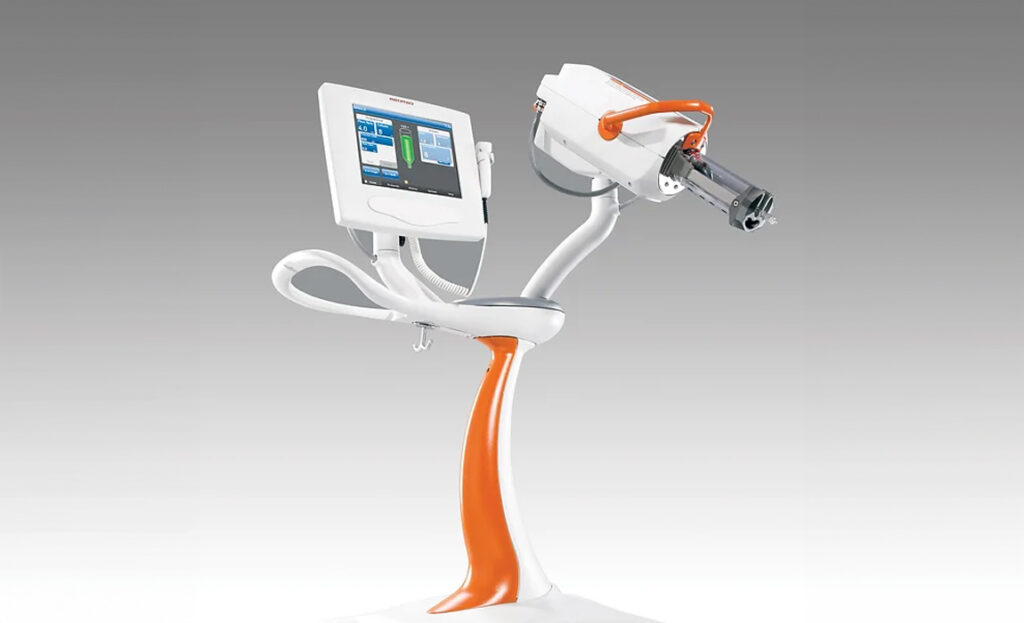Overview
The FDA simply defines an infusion pump as, “a medical device that delivers fluids, such as nutrients and medications, into a patient’s body in controlled amounts.” Infusion systems pump these fluids specifically into a patient’s circulatory system. They are primarily used in hospitals and nursing homes. A Positron Emission Tomography (PET) scan is a screening test, using a radioactive drug (tracer), to show how your tissues and organs are operating.
The Positron Emission Tomography (PET) Infusion System aids in the administration of Fluorodeoxyglucose (FDG)* for patient care – the biologically active molecule, chosen for PET, that is used as a tracer during imaging. Within this system, a chamber is located at the core to store and prolong the shelf life of the radioactive isotope.
Charged to redesign the next generation of the PET Infusion System, MPE’s Industrial Design and Design Engineering Team reached out directly to users at cancer care centers for feedback.
Challenge
The Voice of Customer (VOC) expressed target areas that needed to be resolved in the redesign – the overall size and mobility of the unit. Due to the lead-lined chamber stored within the core (protecting technicians from exposure to stored radioactive isotope within the unit), the weight of the infusion system is significant and disadvantages the transportability of the system. Nurses were having problems moving the cart with ease due to the heavy weight. Although with decreasing the unit’s weight, the system size also need to be decreased because of it being used in small procedure rooms.
The previous model of the PET Infusion System had a manual braking system where the ease of locking the unit was more difficult than it needed to be. An updated breaking system that was automatic was essential in this redesign for even easier movement of the unit.
With an improvement of size and weight, it was also essential for the PET Infusion System’s overall look and appearance to be updated to a sleeker and comforting design to avoid the patient feeling intimidated.
Process
In order to make these necessary redesign enhancements, the MPE Industrial Design and Design Engineering teams collaborated and researched different designs that could be the solution. When identifying and discovering possible solutions, the team kept the customer’s ideal packaging and Industrial Design at the forefront of product development.
The MPE team utilized an outside resource, a company who manufactures wheelchairs, to aid in the process of designing an infusion system with the increased ease of mobility and an automatic breaking system similar to that of a wheelchair.
Solution
Serving the VOC, the MPE team redesigned the PET Infusion System with better ease of transportation and mobility; decreasing the disadvantageous amount of weight. The team utilized a powered drive motor and introduced ergonomic enhancements that increased the transportability of the system – solving the issue of weight.
With a complete and total Industrial redesign, the system was downsized and updated to a modern, reassuring design – eliminating the bulky and intimidating feel. Moreover, the infusion system redesign met and exceeded all expectations in a short period of time.
Results
Serving the VOC, the MPE team redesigned the PET Infusion System with better ease of transportation and mobility; decreasing the disadvantageous amount of weight. The team utilized a powered drive motor and introduced ergonomic enhancements that increased the transportability of the system – solving the issue of weight.
With a complete and total Industrial redesign, the system was downsized and updated to a modern, reassuring design – eliminating the bulky and intimidating feel. Moreover, the infusion system redesign met and exceeded all expectations in a short period of time.
